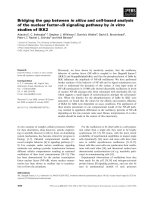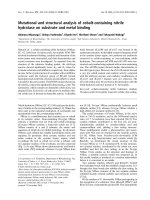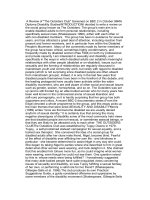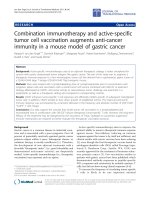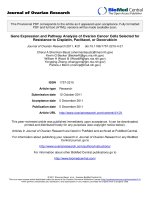Genomic and transcriptomic analysis of gastric cancer systematic studies on transcriptional bias in aneuploidy and gene coexpression meta network
Bạn đang xem bản rút gọn của tài liệu. Xem và tải ngay bản đầy đủ của tài liệu tại đây (7.19 MB, 149 trang )
GENOMIC AND TRANSCRIPTOMIC ANALYSIS
OF GASTRIC CANCER: SYSTEMATIC STUDIES
ON TRANSCRIPTIONAL BIAS IN ANEUPLOIDY
AND GENE COEXPRESSION META-NETWORK
AMIT AGGARWAL
B. Tech, M. Eng
A THESIS SUBMITTED FOR THE DEGREE OF
DOCTORATE OF PHILOSOPHY
DEPARTMENT OF PHYSIOLOGY
FACULTY OF MEDICINE
NATIONAL UNIVERSITY OF SINGAPORE
2006
Acknowledgements
This thesis has been made possible by support of several people. First and foremost I
would like to thank Dr. Patrick Tan (Principal Investigator, National Cancer Centre
of Singapore and Group Leader, Genome Institute of Singapore). This work would
not have been possible if not for his immense encouragement and guidance during
the last few years. It is his enthusiastic supervision and personal guidance that has
transformed an engineer into a scientist.
I am grateful to Prof. Kon Oi Lian (National Cancer Centre, Singapore) and Assoc.
Prof. Suet Yi Leung (Queen Mary Hospital, Hong Kong) first for believing in the
predictions from this work and secondly for providing the biological validation work.
Thanks are also due to the members of Asia-Pacific Gastric Cancer Genomics
Consortium (Prof. Hiroyuki Aburatani, University of Tokyo, Japan; Prof. David
Bowtell, Peter MacCallum Cancer Centre, Australia; Assoc. Prof. Suet Yi Leung,
Queen Mary Hospital, Hong Kong) for allowing me to utilize their database of
microarray data on Gastric Cancer and for numerous feedbacks during the course of
this work. This research work has been supported financially by various
organizations including the Biomedical Research Council of Singapore, the National
Cancer Centre and the Singapore Cancer Syndicate. I thank them all for this
opportunity.
My coworkers at the National Cancer Centre are thanked for the help rendered
during the course of this work and in making my stay really delightful— Leong Siew
Hong and Cheryl Lee for help with the CGH and FISH validation; Jeanie Wu and
Angie Tan for processing some of the microarrays used in this thesis; Yu Kun for
ii
knocking sense into my head, not to mention my work, when it was needed the most;
Kaia Davis and Dr. Lakshimi for the late afternoon discussions over various forms of
caffeine; Dr. Kumerasan for conducting my unofficial laboratory induction and
dinner time discussions over various culinary indulgences (I owe him 5 Kgs); Kala
for driving me back and forth from the classes and helping me through some of the
exams; Dr. Wu Yong Hui and Chen Wei for enduring my incompetent mandarin and
helping me add some competence to it.
This work is dedicated to my parents whose love and support have brought me to
where I am right now.
Amit Aggarwal
National Cancer Centre of Singapore
January 2006
iii
Table of Contents
Acknowledgements ii
Table of Contents iv
Summary vii
Publications based on present work: ix
List of Tables x
List of Figures xi
CHAPTER 1: INTRODUCTION 1
1.1 Microarrays and Global Patterns of Tumor Gene Expression 1
1.2 Gastric Cancer 2
1.3 Motivation 4
1.4 References 8
CHAPTER 2: EXPRESSION BIAS IN REGIONS OF CHROMOSOMAL
ANEUPLOIDY 12
2.1 Introduction 12
2.2 Materials and Methods 14
2.2.1 Cell Lines 14
2.2.2 Comparative Genomic Hybridization(CGH) and Spectral Karyotyping(SKY) 15
2.2.3 Expression Profiling 15
2.2.4 Mapping of Affymetrix Genechip Probes to the Human Genome Sequence 15
2.2.5 Data Preprocessing 16
2.2.6 Wavelet Transforms 16
2.2.7 Continuous Wavelet Transforms and Scale Averaged Variance 17
2.2.8 Wavelet Variance Scanning (WAVES) 19
2.2.9 Confidence Assessment Using Random Permutations 24
2.2.10 Estimating False Discovery Rates for Individual Cell Lines 24
2.3 Results 25
2.3.1 Wavelet Transformations of Gene Expression Information 25
iv
2.3.2 Targeted Analysis of Regions Exhibiting Coordinated Gene Expression Suggests a
Correlation with DNA Amplifications and Deletions 29
2.3.3 WAVES – a Systematic and Unbiased Methodology for Identifying COREs 33
2.3.4 Global Concordance of COREs with Chromosomal Aberrations 40
2.3.5 Performance Comparisons of Wavelet Transformed to Non-Wavelet Transformed
Data 44
2.4 Discussion 48
2.5 References 52
2.6 Appendix 55
2.6.1 Spectral Karyotyping (SKY) Data 55
2.6.2 Comparative Genomic Hybridization Data for Gastric Cell Lines 57
2.6.3 DNA Amplification and Expression Values for Known Oncogenes 65
CHAPTER 3: GENE COEXPRESSION META-NETWORK OF GASTRIC
CANCER 68
3.1 Introduction 68
3.2 Materials and Methods 71
3.2.1 Gene Expression Datasets and Data Pre-processing 71
3.2.2 Identification of Conserved Coexpression Interactions 74
3.2.3 Clustering Coefficient 76
3.2.4. Assembly of Expression Communities and Functional Modules 78
3.2.5 Hierarchical Clustering and Other Software Sources 79
3.2.6 Construction of Gastric Cancer Tissue Microarrays 79
3.2.7 Immunohistochemisty 80
3.3 Results 83
3.3.1 The Gastrome – A Consensus Gene Coexpression Meta-network of Gastric Cancer
83
3.3.2 A Topological Analysis of the Gastrome Reveals a Hierarchical Scale-free
Architecture with Embedded Modularity 88
3.3.3 A Modular Analysis of the Gastrome Reveals both Known and Novel
Coexpression Subnetworks 94
3.3.4 Functional Modules have Highly Distinct Sub-topologies Consistent with their
Different Biological Functions 98
3.3.5 A Gene Neighborhood Analysis of the Gastrome Reveals Novel Interactions
Between Phospholipase PLA2G2A and the EphB2 Receptor 106
3.4 Discussion 112
v
3.5 References 117
3.6 Appendix 121
3.6.1 Summary of Histopathological and Clinical Information of the Tumors in each
Dataset. 121
3.6.2 Definition of Coexpression 122
3.6.3 Robustness of Coexpression Communities 123
3.6.4 Members of Coexpression Communities 124
3.6.5 Possible Functions of Novel Coexpression Modules 125
3.6.6 Robustness of Intestinal Differentiation Module to Non-Malignant Samples 131
3.6.7 Repeated Observation of Intestinal-like and Non-intestinal Like Subclasses of
Gastric Cancers in Multiple Datasets 132
3.6.8 Experimental Manipulation of the Wnt Signaling Pathway Affects PLA2G2A
Expression 136
vi
Summary
Whole-genome sequencing projects have imparted much of the initial
momentum for genome-wide studies, but it is microarrays and their application to
cancer that has proved instrumental in establishing the power of the global view of
genetics. Collections of global ‘microarray snapshots’ of the biological activity at
molecular-level in the biological samples are now providing detailed
characterizations and aiding in attaining an improved understanding of cancer. A key
challenge now lies is in developing statistical and computational techniques that can
extract biologically meaningful information from colossal amounts of data generated
by the global transcription profiling studies. This thesis deals with developing two
new methods to investigate the expression profiles of cancers. First, the existence of
transcriptional bias in the regions of aneuploidy is addressed by showing pervasive
imprinting of aneuploidy on the cancer transcriptome by reconstructing portraits of
chromosomal aberrations using an individual tumor’s gene expression profile. A
signal processing technique called wavelet transform is applied to a series of
genomically arranged expression profiles to identify regions of coordinated
transcription. These regions were subsequently shown to coincide with regions of
aneuploidy. It is suggested that aneuploidy may contribute to tumor behavior by
subtly altering the expression levels of hundreds of genes in the oncogenome.
Second, a probabilistic methodology to construct a gastric cancer coexpression
network is developed using genes that behave similarly across multiple datasets from
disparate expression profiling platforms. The gene-gene coexpression interactions
from different expression datasets of gastric cancer are systematically coalesced into
vii
a single unified coexpression interaction matrix. Subsequently a network is deduced
and methodically explored at the level of network topology and functional modules.
The cellular pathways and biological processes regulating the behavior of gastric
cancer are described and its applicability to gene functional discovery is also shown
through a case study. The methodologies developed in thesis, although, specific to
gastric cancers, are applicable to other cancers as well.
viii
Publications based on present work:
Research Articles:
Amit Aggarwal, Siew Hong Leong, Cheryl Lee, Oi Lian Kon, Patrick Tan. Wavelet
Transformations of Tumor Expression Profiles Reveals A Pervasive Genome Wide
Imprinting of Aneuploidy on the Cancer Transcriptome, Cancer Research, Jan.
2005, 65(1), 186-194.
Amit Aggarwal, Dong Li Guo, Yujin Hoshida, Siu Tsan Yuen, Kent-Man Chu,
Samuel So, Alex Boussioutas, Xin Chen, David Bowtell, Hiroyuki Aburatani, Suet
Yi Leung, Patrick Tan, Topological and Functional Discovery in a Gene
Coexpression Meta-Network of Gastric Cancer, Cancer Research, Jan. 2006, 66(1),
232-241.
Posters
:
Amit Aggarwal, Siew Hong Leong, Cheryl Lee, Oi Lian Kon, Patrick Tan, Wavelet
variance of gastric cancer cell line transcriptomes and its correlation with genomic
aberrations, 95
th
Annual Meeting of the American Association for Cancer Research
2004, Orlando, USA.
Amit Aggarwal, Siew Hong Leong, Cheryl Lee, Oi Lian Kon, Patrick Tan, Genome
wide imprinting of aneuploidy on the gastric cancer transcriptome, Oncogenomics
2005, San Deigo, USA.
Amit Aggarwal, Dong Li Guo, Yujin Hoshida, Siu Tsan Yuen, Kent-Man Chu,
Samuel So, Alex Boussioutas, Xin Chen, David Bowtell, Hiroyuki Aburatani, Suet
Yi Leung, Patrick Tan, Topological and Functional Discovery in a Gene
Coexpression Meta-Network of Gastric Cancer, 96
th
Annual Meeting of the American
Association for Cancer Research 2005, Los Angeles, USA.
Awards:
Scholar-in-Training award. 96
th
Annual Meeting of the American Association For
Cancer Research, 2005.
ix
List of Tables
Table 2.1: Gastric Cell Line characteristics 14
Table 2.2: Spectral Karyotyping (SKY) Data 55
Table 2.3 Gene expression levels of ERBB2 and surrounding genes in gastric cancer
cell lines. 66
Table 2.4 Gene expression levels of oncogenes and proto-oncogenes in gastric cancer
cell lines. 67
Table 3.1: Description of microarray datasets, data pre-processing and profiling
platforms used for the four GC Studies 72
Table 3.2: Data generation and preprocessing details 73
Table 3.3: Patient demographic data and expression of EphB2 and PLA2G2A in the
343 gastric cancers 82
Table 3.4: Comparison of overall clustering coefficients at different LLR
crit
cutoffs
for the gastrome (ĈNo) and equivalent pure scale free (Ĉsf) and random (Gaussian)
networks (Ĉrnd). 93
Table 3.5: Isolation indexes of functional modules at LLR≥8 101
Table 3.6 χ
2
test showing significance of correlation between EphrinB2 protein
expression (EphB2) and Phospholipase A2 Group IIA (PLA2G2A) in-situ expression.
109
Table 3.7 Summary of histopathological and clinical information of the tumors in
each dataset. 121
x
List of Figures
Figure 2.1: Plots of wavelet variance density at various scales for N87, AGS and
SNU1 18
Figure 2.2: Definition of dominance causes underestimation of regions scored
significant 21
Figure 2.3: Wavelet transformations of gene expression data. 27
Figure 2.4: Correlation of wavelet-Gene Expression values to specific chromosomal
aberrations 31
Figure 2.5: Unsupervised detection of COREs 36
Figure 2.6: Performance characteristics of detection methodology 38
Figure 2.7: Genome-wide association of COREs with chromosomal amplifications
and deletions. 42
Figure 2.8: Schematic of the procedure used to compare the performance of wavelet
transformed to non-wavelet transformed procedure. 44
Figure 2.9: Distribution of dominance frequencies of the wavelet and non-wavelet
transformed dominance frequencies for cell line AGS and SNU1. 46
Figure 2.10 : Comparative Genomic Hybridization data for gastric cell lines 57
Figure 3.1: Simulating a pure scale free network using preferential attachment model
77
Figure 3.2: Identification and distribution of conserved coexpression links. 86
Figure 3.3: Topological characteristics of the gastrome 91
Figure 3.4: Connectivity Bias of ‘highly connected’ Genes 92
Figure 3.5: Schematic for organizing expression links into communities and
subsequent modules 96
Figure 3.6: Identification of modules from expression communities. 97
Figure 3.7: Stability in the isolation indexes of the functional modules 102
Figure 3.8: Higher order relationships between communities and modules 103
Figure 3.9: Villin1 expression in gastric adenocarcinomas. 104
Figure 3.10: Presence of intestinal and non-intestinal groups across multiple datasets
and their correlation with Lauren’s intestinal type histological classification 105
xi
Figure 3.11: Expression interactions between EphB2, PLA2G2A, and
β
-catenin 110
Figure 3.12: Robustness of coexpression communities 123
Figure 3.13: Presence of normal-gastric and intestinal signatures in malignant and
non-malignant samples. 134
xii
CHAPTER 1: INTRODUCTION
Tumorigenesis especially in epithelial tissues is marked by the aberrant regulation of
genes involved in cell proliferation, apoptosis, genome stability, angiogenesis,
adhesion and cell-motility and metastasis (1). The key factors that have been
implicated in driving deviant gene functions are changes in genome copy number,
chromosomal translocations, epigenetic modifications, polymorphisms, point
mutations, insertions-deletions etc. Well-known examples include- amplification of
MYC (2) and ERBB2 (3), deletion of tumor suppressors such as PTEN (4), inherited
mutations in BRCA1 and BRCA2 (5), translocation driven fusion of ERG-ETV (6)
etc. Thus, cancer is a complicated disease, which surfaces in diverse cell types and is
accompanied by various alterations in the DNA sequences. Many of these
aberrations are specific to individual cancer types and produce molecular
abnormalities that influence the expression of genes involved in tumor’s growth,
ability to metastasize and response to treatments such as chemotherapy. The
underlying genetic complexity has been difficult to study using traditional methods,
which are best suited to investigating a handful of genes at a time. This complexity
also has confounded the evaluation of new treatment approaches in oncology, since
clinically homogeneous patient populations often represent molecularly
heterogeneous patient subsets.
1.1 Microarrays and Global Patterns of Tumor Gene Expression
Cancer is a complex heterogeneous disease displaying varied cellularity, genetic
modifications and clinical behaviors. Microarray technology has given researchers
1
the ability to rapidly measure the expression levels of tens of thousands of genes
simultaneously in a biological system under investigation (7,8). Thus, by using
microarrays coupled with statistical and pattern recognition techniques to detect
similarities and differences among tumors, researchers have now been able to
catalogue unprecedented amount of information about the changes that underlie
different cancers (9). Consequently, mainstream cancer research has undergone a
rapid metamorphosis following the induction of microarray technologies. The focus
is rapidly moving from studying genes in isolation to large-scale or genome-wide
studies involving simultaneous measurement of changes in thousands of genes,
which in turn provides a more complete and somewhat unbiased view of the
biological state of the cell. Although, these profiling experiments are broad discovery
or exploratory studies but they are providing an invaluable resource for
understanding basic biological processes and thereby aiding in the understanding of
the cancer cell. Some examples are molecular subtyping of cancers (10-13),
identification of diagnostic and prognostic markers (14-17), common gene functional
and regulatory patterns shared by cancers (18,19), improving the sensitivity to detect
new disease subtypes that can not be detected using standard biochemical assays and
traditional light microscopy based approaches (20) etc. In conclusion, microarray is
indeed a tool that has provided us with a high-throughput approach for understanding
the cancer biology through systematic analysis of whole genomes and
transcriptomes.
1.2 Gastric Cancer
Gastric cancer is a leading cause of cancer mortality worldwide, surpassed only by
lung cancer (21). At present, the successful treatment and its prevention are plagued
2
by several clinical challenges. Most patients are presented at advanced stages, as
there is currently no practical screening method for achieving early diagnosis.
Therapeutically, only surgery confers a survival benefit (22) while chemotherapy is
largely palliative (23). Despite a steadily declining overall incidence, the disease is
still highly prevalent in the Asia-Pacific region, where it remains a major health-care
challenge (24). A major difficulty in the diagnosis and treatment of gastric cancer is
that very few of the currently utilized classification schemes are strong predictors of
clinical behavior. Traditional classifications of gastric cancer on the basis of mucin
content, histological architecture and cellular differentiation status are highly subject
to inter-observer variation and are thus neither robust nor clinically meaningful (25).
To date, only tumor staging is a proven prognosticator of gastric cancer (26).
However, reliance on tumor staging alone is insufficient to fully sub-classify this
disease, especially given the growing body of epidemiological evidences suggesting
that gastric cancer is a complex disease whose pathogenesis is dependent on several
genetic, clinical and dietary factors –
I) Genetic factors: blood group A and parental history of gastric cancer (27),
germline E-cadherin mutation (28) and DNA mismatch repair genes (29),
polymorphisms in Interleukin-1B and the Interleukin receptor IL-1RN (30). II)
Clinical factors: infections of helicobacter pylori (31) and premalignant gastric
lesions (32). III) Dietary factors: salt rich diets (33).
In spite of these advances, relatively little is still currently known about the
fundamental biology of gastric cancer, particularly when compared to other major
cancer types, including breast, colon and prostate cancer.
3
1.3 Motivation
The application of molecular diagnostics, in which the pathologic classification of
tissues is based on a set of molecular and genetic markers, is a promising alternative
to traditional techniques for the development of disease taxonomies that are clinically
relevant. It is with this aim expression profiling of gastric cancers was conducted at
our lab titled: A Combined Comparative Genomic Hybridization and Expression
Microarray Analysis of Gastric Cancer Reveals Novel Molecular Subtypes (34). This
study was successful in identifying novel molecular subtypes and genomic
aberrations and discovered that gastric tumors could be grouped by their expression
profiles into three broad classes: “tumorigenic,” “reactive,” and “gastric-like” with
patients with gastric-like tumors exhibiting a significantly better overall survival. It
laid the groundwork for the present research work by raising two main questions and
this work attempts to answer them. First, no correlation could be observed between
aneuploidy and change in transcripts level. Thus an unbiased methodology was
needed to evaluate the effect of aneuploidy on the gastric cancer transcriptome. This
work is briefly described in section-A below and detailed in Chapter 2. Secondly,
several research articles were published describing the molecular subclasses of
gastric cancer, but they lacked consistency among them. An analytical technique was
needed to systematically combine the data on gastric cancers from disparate
platforms. This work is briefly described in section-B below and detailed in Chapter
3.
A) No correlation could be observed between aneuploidy and change in transcript
levels where as others (35,36) reported ambiguous results regarding the existence
of a correlation between change in transcript level and the aneuploidy using
4
similar biotechniques. It was hypothesized that in the event of aneuploidy
exerting a pervasive effect on gene expression, its effects should be ‘imprinted’
on the cancer transcriptome. Thus, an appropriate analytical tool was needed to
reconstruct the portrait of chromosomal aberrations using an individual tumor’s
gene expression profile. To ascertain if the aneuploidy profile could be
reconstructed de novo from gene expression data, wavelet transform (37) based
methodology was developed to identify regions of coordinated transcription
within a target genome. Wavelets can be thought of as small waves using which
one can measure local or global topology by varying the scale and translating it
along the signal. The continuous wavelet transform is known for its ability to
accentuate the recurrent temporal patterns. It was thus applied to a series of
genomically arranged gastric cancer cell line gene expression data followed by
comparing the results to randomly arranged gene expression data to estimate the
false discovery rate. Thus, using a combination of signal processing and
statistical methodology, we identified several distinct regions of coordinated
transcription. Interestingly, these co-regulated regions were more frequently
observed in cell lines with large numbers of chromosomal aberrations.
Comparing the above regions with chromosomal comparative genomic
hybridization (CGH) data, a large majority (~80%) of these co-regulated regions
could be specifically localized to a site of chromosomal aneuploidy. Also, up to
47% of the total aneuploidy in the tumor cell lines could be directly inferred by
this analysis without requiring apriori knowledge of the specific genomic
locations of the chromosomal aberrations. The fact that the genome-wide portrait
of tumor aneuploidy is constructible from gene expression data suggested that the
5
effects of chromosomal aneuploidy are pervasively imprinted on the cancer
transcriptome. This work is described in Chapter 2.
B) Several similar genome-wide studies on gastric cancer (38-40) appeared thereby
providing insights into the molecular heterogeneity of gastric cancers. These
studies showed that individual gastric tumors are indeed highly molecularly
heterogeneous, and that in many cases, this heterogeneity is clinically significant.
Poor consistency was observed between the molecular subtypes reported by us
(34) and other groups (38-40). In each of the studies, preprocessed data were
subjected to unsupervised learning techniques and the resulting molecular
subtypes were reported on the basis of genes that clustered together. This led to
inter-study discrepancies that could not be reconciled due to several confounding
factors such as different patient populations and microarray platforms. A
framework was needed that could combine data across multiple technology
platforms. A probabilistic measure of coexpression interaction between a gene-
pair was derived based on the consistency of their correlation across multiple
expression datasets. This was compared to a random case to compute the
likelihood of a gene-gene correlation being random. To identify discrete
molecular sub-networks, a novel clustering algorithm was developed to organize
the significant gene-gene relationships into distinct ‘expression communities’.
The topological properties of the network and the constituent modules were
assessed to gain insight into the organization of information in gene coexpression
networks. Four datasets comprising >300 tissue samples from four independent
patient populations were subjected to the above methodology. Topological
analysis of meta-network revealed a hierarchical scale-free architecture, with
6
embedded modularity. Several modules of distinct biological functions including
protein biosynthesis, immune response, cellular proliferation, and gastro-
intestinal function were identified. These modules possessed distinct topologies:
some (eg cellular proliferation) were integrated within the primary network,
while others (eg ribosomal biosynthesis, digestive enzymes) were relatively
isolated. Intriguingly, intestinal differentiation module exhibited a remarkably
high degree of autonomy, suggesting that topological constraints may contribute
to the frequent occurrence of intestinal metaplasia. Functional study of
PhospholipaseA2 group IIA (PLA2G2A; gene of prognostic significance in
gastric cancers, Ref 41) was carried out through analysis of genes in its
coexpression neighborhood to reveal its association with WNT-signaling
pathway. Thus, a methodology for systematic analyses at the level of network
topology, functional modules, and constituent genes in gastric cancer was
developed to identify cellular pathways and processes regulating the behavior of
gastric cancer. It was used to identify a) systems-level features, and b) subtle but
significant functional gene relationships relevant to gastric tumor biology. This
work is described in Chapter 3.
7
1.4 References
1. Hanahan D and Weinberg RA. The hallmarks of cancer. Cell 2000;100:57-70.
2. Little CD, et al. Amplification and expression of the c-myc oncogene in human
lung cancer cell lines, Nature 1983;306:194-196.
3. Slamon DJ, et al. Studies of the HER-2/neu proto-oncogene in human breast and
ovarian cancer. Science 1989;244:707-712.
4. Li J, et al. PTEN, a putative protein tyrosine phosphatase gene mutated in human
brain, breast and prostate cancer. Science 1997;275:1943-1947.
5. Ford D, et al. Genetic Heterogeneity and Penetrance Analysis of the BRCA1and
BRCA2 Genes in Breast Cancer Families: The Breast Cancer Linkage Consortium.
Am J Hum Genet 1998;623:676-689.
6. Tomlins SA, et al. Recurrent Fusion of TMPRSS2 and ETS Transcription Factor
Genes in Prostate Cancer. Science 2005;210:644-648.
7. Dungan DJ, et al. Expression profiling using cDNA microarrays, Nat Genet
1999;21:10-14.
8. Lipshutz RJ, et al. High density synthetic oligonucleotide arrays, Nat Genet
1999;21:20-24.
9.
from University of Michigan, comprising of ~10k
expression profiles from 31 different cancers (Dec 2005).
10. Perou CM et al. Molecular portraits of human breast tumours. Nature 2000;406:
747-752.
11. Bhattacharjee A, et al. Classification of human lung carcinomas by mRNA
expression profiling reveals distinct adenocarcinoma subclasses. Proc Natl Acad Sci
USA 2001;98:13790-13795.
8
12. Zou TT, et al. Application of cDNA microarrays to generate a molecular
taxonomy capable of distinguishing between colon cancer and normal colon.
Oncogene 2002;21:4855−4862.
13. MacDonald TJ, et al. Expression profiling of medulloblastoma: PDGFRA and the
RAS/MAPK pathway as therapeutic targets for metastatic disease. Nat Genet
2001;29:143−152.
14. Beer DG, et al. Gene-expression profiles predict survival of patients with lung
adenocarcinoma. Nature Med 2002;8:816-824.
15. Takahashi M, et al. Gene expression profiling of clear cell renal cell carcinoma:
gene identification and prognostic classification. Proc Natl Acad Sci USA
2001;98:9754−9759.
16. van 't Veer LJ, et al. Gene expression profiling predicts clinical outcome of breast
cancer. Nature 2002;415:530-536.
17. Dhanasekaran SM, et al. Delineation of prognostic biomarkers in prostate cancer.
Nature 2001;412:822−826.
18. Rhodes DR, et al. Large-scale meta-analysis of cancer microarray data identifies
common transcriptional profiles of neoplastic transformation and progression. Proc
Natl Acad Sci USA 2004;101:9309-9314.
19. Rhodes DR, et al. Mining for regulatory programs in the cancer transcriptome,
Nat Genet 2005;37:579-583.
20. Liu ET. Classification of cancers by expression profiling. Curr Opin Genet Dev
2003;13(1):97-103.
21. Parkin DM, et al, Global cancer statistics, CA Cancer Journal for Clinicians
1999;49(1):33-64.
9
22. Kim JP, et al. Clinicopathologic characteristics and prognostic factors in 10783
patients with gastric cancer, Gastric Cancer 1998;1:125-133.
23. Wohrer SS, et al. Palliative chemotherapy for advanced gastric cancer. Ann
Oncol 2004;15(11):1585-1595.
24. The Scientist, 2003, 17 (S42).
25. Dixon MF, et al. D. Goseki grading in gastric cancer: comparison with existing
systems of grading and its reproducibility, Histopathology 1994;25:309-316.
26. Wu CW, et al. Prognostic indicators for survival after curative resection for
patients with carcinoma of the stomach. Dig Dis Sci 1997;42:1265-1269.
27. You WC, et al. Blood type and family cancer history in relation to precancerous
gastric lesions, Int J Epidemiol 2000;29(3):405-407.
28. Guilford P, et al. E-cadherin germline mutations in familial gastric cancer.
Nature, 1998;392:402-405.
29. Simpson AJ, et al. Microsatellite instability as a tool for the classification of
gastric cancer. Trends Mol Med 2001;7(2):76-80.
30. El-Omar EM, et al. Interleukin-1 polymorphisms associated with increased risk
of gastric cancer. Nature 2000;404:398-402.
31. The EUROGAST Study Group, An international association between
Helicobacter pylori infection and gastric cancer. Lancet 1993;341(8857):1359-1362.
32. Correa P, et al. Gastric precancerous process in a high risk population: cross
sectional studies. Cancer Res 1990;50:4731-4736.
33. Tsugane S. Salt, salted food intake, and risk of gastric cancer: epidemiologic
evidence, Cancer Sci 2005;96(1):1-6.
10
34. Tay ST, et al. A combined comparative genomic hybridization and expression
microarray analyses of gastric cancer reveals novel molecular subtypes, Cancer Res
2003;63:3309-3316.
35. Phillips JL, et al. The consequences of chromosomal aneuploidy on gene
expression profiles in a cell line model for prostate carcinogenesis, Cancer Res
2001;61:8143-8149.
36. Platzer P, et al. Silence of Chromosomal Amplifications in Colon Cancer, Cancer
Res 2002;62:1134-1138.
37. Lio P. Wavelets in bioinformatics and computational biology: state of art and
perspectives, Bioinformatics 2003;19:2-9.
38. Boussioutas A, et al. Distinctive Patterns of Gene Expression in Premalignant
Gastric Mucosa and Gastric Cancer, Cancer Res 63;2003:2569-2577.
39. Chen X, et al. Variation in Gene Expression Patterns in Human Gastric Cancers,
Mol Biol Cell 2003;14:3208-3215.
40. Hippo Y, et al. Global Gene Expression Analysis of Gastric Cancer by
Oligonucleotide Microarrays. Cancer Res 2002;62:233-240.
41. Leung SY, et al. Phospholipase A2 group IIA expression in gastric
adenocarcinoma is associated with prolonged survival and less frequent metastasis.
Proc Natl Acad Sci USA 2002;99:16203-16208.
11
CHAPTER 2: EXPRESSION BIAS IN REGIONS OF
CHROMOSOMAL ANEUPLOIDY
2.1 Introduction
Aneuploidy is one of the most frequently observed genetic aberrations in human
cancers, and tumors with increasingly abnormal karyotypes (eg chromosomal
amplifications, duplications and deletions) are often associated with greater
aggressiveness, chemoresistance, and tendency for metastasis, suggesting a
functional role for these genomic aberrations in shaping tumor behavior (1-3).
Despite its ubiquitous nature, the specific effects of such large-scale chromosomal
aberrations on the cancer cell, in particular the cancer transcriptome, remain
controversial. For example, although certain groups have shown that alterations in
DNA copy number can play a major role in determining a gene’s expression level (4-
8), others have reported that genes on regions of chromosomal amplification are
rarely associated with increased expression (9). In addition, most of these reports
have focused on specific regions, such as sites of recurrent chromosomal
amplification (5,8-10) and may thus have been inherently biased. In order to resolve
this issue and to understand the role of aneuploidy in the carcinogenic process, a
systematic and unbiased genome-wide survey of the relationship between aneuploidy
and cancer gene expression is required.
We reasoned that if aneuploidy truly exerts pervasive effects on gene expression,
then I) the effects of aneuploidy should be ‘imprinted’ within the cancer
transcriptome, and II) with the appropriate tools, it should be possible to deconvolute
an individual tumor’s gene expression profile to directly infer and reconstruct the
specific portrait of chromosomal aberrations inherent to that tumor. A major
12
difficulty in this regard is that the absolute expression levels of individual genes can
vary tremendously, even when they localized in close physical proximity in the
genome. Indeed, to our knowledge, there is no report that has successfully
demonstrated that global gene expression information can be deconvoluted in a
systematic and unbiased manner to derive a specific genome-wide de novo portrait of
tumor aneuploidy. To address this challenge, we developed a novel methodology,
Wavelet Variance Scanning (WAVES), which employs wavelet transform signal
processing algorithms to identify regions of coordinated transcription within a target
genome. By applying WAVES to a series of gastric cancer cell lines, we identified
several (>100) distinct regions of coordinated transcription, and found that these co-
regulated regions were more frequently observed in cell lines with large numbers of
chromosomal aberrations. Remarkably, the large majority (~80%) of these co-
regulated regions could be specifically localized to a site of chromosomal
aneuploidy, and up to 47% of the total aneuploidy in the tumor cell lines could be
directly inferred by the WAVES analysis, without requiring a priori knowledge of
the specific genomic locations of the chromosomal aberrations. Compared to
methodologies relying on absolute gene expression levels, WAVES also appears to
be a superior test for identifying regions of coordinated expression. This result has
significant implications for cancer biology as it strongly suggests that aneuploidy
does indeed act to drive pervasive and widespread gene expression changes
throughout the cancer transcriptome. Our results confirm and extend previous reports
proposing that aneuploidy may contribute to tumor behavior not just by affecting the
expression of a few key oncogenes and tumor suppressor genes, but also by subtly
altering the expression levels of hundreds of genes in the cancer genome.
13

